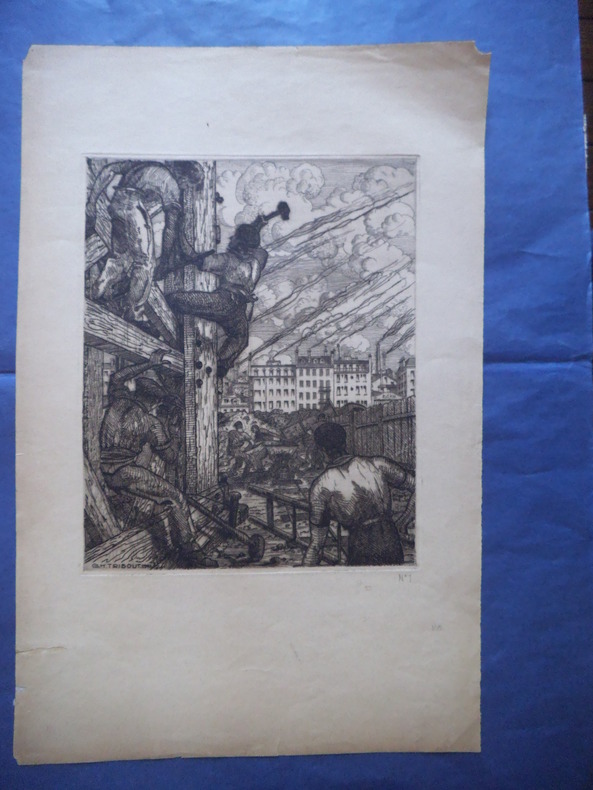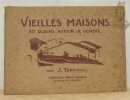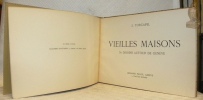-
Type
Any type (2)
Art print (7)
Book (31208)
Disk (1)
Drawings (7)
Engraving (10)
Magazine (130)
Old papers (1)
Photographs (14)
Posters (4)
-
Latest
Last 24h (3)
Last 3 days (19)
Last month (296)
Last week (42)
-
Language
Dutch (1)
English (54)
French (31283)
German (6)
Italian (18)
Japanese (2)
Portuguese (9)
Spanish (11)
-
Century
16th (16)
17th (56)
18th (214)
19th (1583)
20th (9405)
21st (1684)
-
Countries
Belgium (9472)
Brazil (7)
Canada (108)
China (3)
Côte d'Ivoire (63)
Denmark (215)
France (18507)
Germany (1)
Greece (1)
Italy (36)
Switzerland (2971)
-
Syndicate
ALAC (99)
CLAM (42)
CLAQ (94)
CNE (3)
ILAB (10975)
NVVA (1161)
SLACES (1161)
SLAM (8449)
SNCAO (9)
Qu'est-ce que l'architecture aujourd'hui ?
Paris Beaux Arts Editions 2007 1 vol. broché in-4, broché, couv. illustrée, 188 pp., nombreuses photos en couleurs. Très bon état.
Mario Botta. La maison ronde
L'Equerre L'Equerre, 1982. In-8 carré broché de 103 pages. Photos et plans. Bon état
Toutes les expéditions sont faites en suivi au-dessus de 25 euros. Expédition quotidienne pour les envois simples, suivis, recommandés ou Colissimo.
5 CHEFS D'OEUVRES DE L'ARCHITECTURE MONDIALE PANORAMIQUE
SOLAR. 1996. In-4. Relié. Bon état, Couv. convenable, Dos satisfaisant, Intérieur frais. 79 pages. Nombreuses illustrations en noir et blanc, et en couleur, dans le texte et hors texte, par Paul Drapper.. . . . Classification Dewey : 720-Architecture
Classification Dewey : 720-Architecture
PANORAMIQUES- 5 CHEFS-D OEUVRE DE L ARCHITECTURE MONDIALE
SOLAR. 1995. In-4. Relié. Bon état, Couv. convenable, Dos satisfaisant, Intérieur frais. 77 pages- nombreuses pages pliantes- frontispice images couleurs. . . . Classification Dewey : 720-Architecture
Saint Pierre de Rome- Buckingham- Opéra Garnier- Neuschwanstein- Monticello/ Illustrations Paul Draper Classification Dewey : 720-Architecture
Eglises du Pays Basque. Le Labourd. [ Aïnhoa - Arcangues - Cambo - Ciboure - Espelette - Halsou - Itxassou - Macaye - Saint-Pée sur Nivelle - Sare - Souraïde ]
Dessinées et gravées par Triaud, préface de E. Goyheneche, 1 vol. in-4 sous chemise avec 1 f. de texte et 11 gravures sur bois contrecollées sur feuillet blanc, Triaud, Cambo, s.d. [ 1970 ]
Etat très satisfaisant (qq. rouss. et frott. en chemise et feuillet de texte, gravures en très bon état)
L'échoppe bordelaise. Bordeaux, la ville aux dix mille échoppes.
Avant-propos de Michel Pétuaud-Létang, 1 vol. petit in-4 br., A Editions, 1997, 157 pp.
Bon état. Rare exemplaire de cet ouvrage de référence !
Nos gares et leur personnel. Cahiers des CFF, N° 2.
Lausanne, Librairie Payot, 1949. 13 x 20, 97 pp., 50 photographies hors texte, 29 croquis, broché, bon état (cachet d'ex-propriétaire).
Adaptation française de H. Bayard.
sans titre
deux eaux-fortes originales datées de 1943 et 1944 ,période "architecture" signature au bas à gauche pour la première et à droite pour la seconde;1943 :322x238mm à la cuvette 560x400mm avec la marge 1944 : 296x238 à la cuvette et 322x502 avec la marge
NOTRE-DAME DU MARILLAIS A TRAVERS LES AGES
1938 broché in-octavo carré (paperback in-octavo), dos muet gris-bleu (grey-blue spine - no title), première de couverture illustrée (front cover illustrated), gouttière non coupée (fored-edge uncut), illustrations de Roger Jusserand, VIII+93 pages, 1938 à Angers Siraudeau Editeur,
préface de Francis Vincent - bon état (very good condition)
ENSORIANA
, PANDORA 1995, 1995 Softcover, 104 pagina's, Texte en Francais, 240 x 175 mm, Tres belle exemplaire, beaucoup illustrations de maitre,. ISBN 9789053250273.
James Ensor. Catalogue Raisonne des peintures I -1875-1902 / II- 1902-1941
, Pandora-Ortelius 1992., 1992 Couvertures rigides; Complet en deux tomes. Quarto, 305 x 255 mm. Tome I : 1875-1902. 384 pp., 38 illustrations couleur et 388 monochromes. Tome II : 1902-1941. 385-720 pp., 22 illustrations couleur et 449 monochromes. Livres sous tui. *tres bon etat. ISBN 9789034105882.
James Ensor scenes from the Life of Christ.
, Vanhoegaerden Gallery, Knokke, 2020 Hardcover HB, 160 pages, throughout colour illustrations. ENGLISH edition. ISBN 9789053254745.
In 1912-1913, James Ensor produced a series of 32 drawings in coloured pencil titled Sc nes de la vie du Christ [Scenes from the life of Christ]. Each drawing on paper measures about 15 by 21 cm. The series depicts different episodes from the lives of Jesus and the Virgin Mary. In it, Ensor managed to combine the sublime and the grotesque in an unsurpassed manner. Some compositions are quite conventional, others typically 'Ensorian', and some even humorous. Among the works in the series is a drawing in which Ensor portrays him-self as Christ, confronted with a dozen Belgian art critics who have gathered before him. In 1929 the drawings were made into lithographs and published in the form of an album by Galerie Georges Giroux in Brussels. These drawings can be considered as a link between the Ostend master's early and later oeuvre. The series combines various motifs which Ensor also executed in oil paint. The author of the work, Xavier Tricot, also pays close attention to the figure of Christ in James Ensor's work. From 1885 onward, the figure of Christ occupied a central position in Ensor's oeuvre. In some of his works, the artist identified with the Messiah
JAMES ENSOR The Entry of Christ into Brussels in 1889
, Pandora Uitgeverij, 2020 Hardcover, 325 x 245 mm, 230 pages ill color, English edition. fine! ISBN 9789053254660.
During 1889, Belgian artist James Ensor (1860-1949) painted a monumental canvas that would be his magnum opus: The Entry of Christ into Brussels in 1889. The work is one of the most complex paintings ever painted. It is only forty years after its completion that the monumental canvas was first publicly exhibited at the James Ensor retrospective at the Brussels Palais des Beaux-Arts in 1929. Needless to say, therefore, that the exhibiting of Ensor's work in 1929 was for many a revelation. Until then it had been seen and was known only to a limited group of visitors and insiders. Between 1889 and 1929, a veritable revolution had taken place in the visual arts. Before and during World War I, Fauvism, Cubism, Futurism, Expressionism, and Dadaism all came into being. Few explanations can accommodate the full daring and frenzy of such a painting which chaotic composition and barbaric style seem revolutionary, and look far beyond the early twentieth century. Since the purchase of the work in 1987 by the J. Paul Getty Museum (Los Angeles), The Entry has acquired cult status. No other work depicts the notion of belgitude so aptly as The Entry of Christ into Brussels in 1889, and yet the painting can in the first place be regarded as a somewhat quirky but striking representation of Ensor's vision of humanity.
Leon Spilliaert Oeuvrecatalogus van de prenten - catalogue raisonne des estampes - catalogue raisonne of the prints.
, Pandora Uitgeverij, 2020 Gebonden, Hardcover.HB, 297 x 245 mm, 195 pages , throughout colour illustrations Eng/ FR/ NL edition. **Nieuwstaat! ISBN 9789053254677.
Het grafische oeuvre van L on Spilliaert (1881-1946) werd lang weinig of niet besproken. Pas in 1982 werd er een eerste tentoonstelling volledig aan gewijd. Spilliaerts prenten, kaft- en boekillustraties zijn misschien minder bekend dan zijn originele werken op papier, maar ze zijn minstens zo mysterieus en aanlokkelijk en zo gevarieerd inzake onderwerp: portretten, figuren, landschappen, stadsgezichten, bossen en parken,. Samen met stadsgenoot James Ensor, wordt Oostendenaar L on Spilliaert vandaag als n van de pioniers van de Belgische moderne kunst beschouwd. Ruim 35 jaar na de eerste tentoonstelling en naar aanleiding van de tentoonstelling L on Spilliaert. De collectie van de Koninklijke Bibliotheek van Belgi in de Venetiaanse Gaanderijen in Oostende, van 30 juni tot 30 september 2018, geeft Pandora Publishers, na de uitgave in 1994, de nieuwe en bijgewerkte editie uit van de oeuvrecatalogus van de prenten van L on Spilliaert door Xavier Tricot. Pendant des ann es, l'oeuvre graphique de L on Spilliaert (1881-1946) n'a t tudi que fort peu ou pas du tout. Ce n'est qu'en 1982 qu'une premi re exposition lui fut consacr e. Les estampes de Spilliaert, ses illustrations de couvertures et de livres sont sans doute moins connues que ses oeuvres originales sur papier, mais elles sont au moins aussi myst rieuses et attrayantes, et aussi vari es quant leur sujet : portraits, figures, paysages, vues de villes, for ts et parcs. L'Ostendais L on Spilliaert est, ainsi que son concitoyen James Ensor, consid r aujourd'hui comme un des pionniers de l'art moderne belge. Plus de 35 ans apr s la premi re exposition et l'occasion de l'exposition L on Spilliaert. La collection de la Biblioth que Royale de Belgique dans les Galeries v nitiennes d'Ostende, du 30 juin au 30 septembre 2018, les ditions Pandora Publishers publient une dition nouvelle et augment e du catalogue des estampes de L on Spilliaert par Xavier Tricot. For a long time, the graphic oeuvre of L on Spilliaert (1881-1946) was, if not neglected, then at least discussed little or summarily. It is only in 1982 that the first exhibition fully devoted to his prints was held. The prints of Spilliaert are perhaps less known than his original works on paper but they are equally mysterious, attractive and varied on topic: portraits, figures, land- and cityscapes, forests and parks,. Together with fellow citizen of Ostend James Ensor, L on Spilliaert is considered one of the pioneers of Belgian modern art. Over 35 years after the first exhibition and because of the exhibition L on Spilliaert. The Collection of the Royal Library of Belgium at the Venetian galleries from 30 June till 30 September 2018, Pandora publishes, a new and updated edition of the catalogue raisonn of the prints of L on Spilliaert by Xavier Tricot.
Leon Spilliaert prenten en illustraties / estampes et illustrations / prints and illustrations. Beredeneerde catalogus / Catalogue Raisonne.
Antwerpen, Pandora , 1994 Gebonden, lichtgrijze linnen hardcover met grijze opdruk, originele uitgeversomslag in kleur met flappen, frontispice in z/w, 30.5x25.5 cm., 110 pp. + 1, geillustreerd in z/w en in kleur, drietalige editie Nederlands/Francais/English. ISBN 9053250247.
Leon Spilliaert catalogus van zijn grafisch werk.
Oostende , Stedelijk Museum voor Schone Kunsten, 1982 Oorspronkelijk uitgevers omslag, 28 pag. met illustraties z/w.
genummerde oplage van 300 exemplaren.
Elémens de Fortification, et de l'attaque et de la défense des places.
Paris, Cellot, Didot fils aîné, Royez, 1786. 130 X 200 mm. 2 tomes reliés demi-basane marron à coins, dos lisse avec pièces de titre et de tomaison en basane chaudron (rel. de l'ép.). XXX-376 et X-316- 1 f. de tables-2 pp. Avec 51 planches gravées dépliantes. Dos lég. frotté avec la coiffe du tome 1 fendue.
Phone number : 41 021 964 60 10
Élémens de fortification, de l'attaque et de la défense des places.
1768 Couverture rigide Paris, Versailles, chez J.B.G. Musier fils, Lefebvre, 1768. In-8, reliure d'époque plein veau havane, dos à nerfs orné, pièce de titre en maroquin rouge, tranches rouges, épidermures, charnières frottées, petit manque à la coiffe supérieure, charnière inférieure fendillée en tête. XXVI, 417 (3) pages, tableau dépliant page 101, 36 planches dépliantes gravées sur cuivre en fin d'ouvrage (33 planches numérotées, planches 4A, 7A, 16A). Didier-Grégoire Trincano était ingénieur, mathématicien, professeur aux écoles d'artillerie de Besançon. Bon état du texte et des planches. Bon exemplaire.
Bon
Caesar's Past and Posterity's Caesar
, Brepols, 2021 Paperback, xii + 248 pages, Size:216 x 280 mm, Illustrations:42 b/w, 11 col., 1 tables b/w., Language: English. ISBN 9782503591308.
Summary Gaius Julius Caesar was the first to design a forum in his family's name. The forum itself had two focal points - a temple to Venus Genetrix and an equestrian statue of Caesar himself - carefully juxtaposed to create a narrative of a strong, enterprising, and controversial sovereign to whom legitimacy was granted by his divine lineage and links to Rome's mythical founders. Through this design, the expansion of the older Forum Romanum thus became a promotion of Caesar himself in a clever show of identity politics. It was a bold - and ultimately fatal - undertaking, and it demonstrates a political vision that not only divided his contemporaries but that has continued to drive scholarly debate, with Caesar variously realized as a mirror for Antiquity, a representative of an age, and a ruler to be examined in relation to all applicable dilemmas and conflicts. This important volume offers new insights into the legacy of Julius Caesar by focusing on two central questions: how did he use the past to construct his own persona as head of the Roman State and Empire? And how has he been remembered - and used - by posterity? Contributions from a range of fields, among them archaeology, classical studies, and history, engage with these questions as they explore Caesar's own self-fashioning through his use of city space, rituals, wars, history, and literature, as well as tracing how he and his actions have been understood, justified, criticized, and used in the centuries since his death, from late antique literature to nineteenth-century drama. TABLE OF CONTENTS List of Figures List of Abbreviations The Man behind the Sources: Caesar's Past and Posterity's Caesar - TRINE ARLUND HASS and RUBINA RAJA I. Caesar and his Time The Role of the Romans' Early History in the Late Republican Period - SINE GROVE SAXKJ R Caesar and the Pomerium of Rome - PAOLO LIVERANI Shaping Caesar's Past for Posterity: Caesar d. f. Augustus - KARL GALINSKY Creating Memories in and of Urban Rome: The Forum Iulium - RUBINA RAJA and JORG RUPKE The Invention of Civil War Writing: The (Curious?) Case of Caesar - CARSTEN HJORT LANGE II. Caesar in Antique Historiography - in Retrospect Caesar's Place in the Course of Tiberian Historiography - BRIDGET ENGLAND Caesar the Orator in Retrospect - HENRIETTE VAN DER BLOM Between Dynast and Legitimate Monarch: Imperial Reflections of Julius Caesar - JESPER MAJBOM MADSEN Julius Caesar in Western Late Antiquity - GIUSEPPE ZECCHINI III. Post-Antique Historiography and Modern Perceptions Should They Rot in Hell? Fifteenth-Century Discussions of Brutus and Cassius - and Caesar's Murder - MARIANNE PADE Lurking in the Jacobean Shadows: Historicity and Topicality of the Character of Julius Caesar in Ben Jonson's Catiline: His Conspiracy - MIRYANA DIMITROVA A Bad Tyrant Born to Command: N. F. S. Grundtvig's Representation of Caesar in the Handbook of World History (1833) - TRINE ARLUND HASS Ancient Contemporary History and Enlightened Philosophy of History: Caesar and Voltaire as Models for Frederick the Great's Historiography - THOMAS BISKUP Lessons in History: Bernard Shaw's Discomforting Caesar - MARIA WYKE The Forum of Caesar: A Historiographical Review - NIKOLINE SAUER
PROGETTO NOTO. Catalogo generale della Mostra . Noto - Palazzo Nicolaci a cura di Corrado Latina i Salvatore Tringali.
Comune de Noto, 1989, Stampa : Editrice Grafica l'Etruria, Cortona ; in-4° carré broché, couverture noire illustrée en blanc, titre en rouge, dos muet; 177pp.; illustré de très nombreux dessins de plans en noir et blanc et de photographies en couleurs.
Le Risorse del territorio : Il patrimonio archeologico. Le risorse naturali e le oasi ambientali. Storia e Cultura: Gli architetti della Noto del '700. Noto nella cultura scientifica e umanistica. Bibiografia. L'Architectura e la Citta : Gli interventi per l'emergenza. I progretti per il recupero e la valorizzazione del patrimonio sorico monumentale del val di Noto. Rilievo ed informatizzazione dem patrimonio architettonico I progetti di riqualificazione urbana a livello infrastructturale e gli interventi di nuova costrizione. Il recupero del connettivo abitativo e dei quartieri populari del centro storico. Le Risorse Umane. l'esperienza teatrale a Noto fra tradizione ed evolazione. la Scena di Noto per i maetri del cinema. Mestieri che scompaiono. Ouvrage en italien. ( GrF)
Vieilles maisons, 30 dessins autour de Genève.
Genève, Librairie Payot 1925, 245x340mm, reliure toile de l’éditeur avec rousseurs et haut de la charnière supérieure fendillée sur 7 cm. Format oblong, intérieur propre. Exempaire sur papier vélin, numéroté n.° 297 / 325.
complet des 30 planches (collation effectuée) n/b imprimées sur les presses lithographiques des ateliers Atar, Pour un paiement via PayPal, veuillez nous en faire la demande et nous vous enverrons une facture PayPal
[REPERANT (Dominique).] - TROCHET (Jean-René).
Reference : 100052
(2006)
ISBN : 9782842775995
La France rurale : maisons paysannes et petit patrimoine.
Paris Chêne 2006 1 vol. relié grand in-4, cartonnage sous jaquette illustrée, 269 pp., nombreuses photos en couleurs de Dominique Repérant. Petites déchirures en bordure de la jaquette, sinon en très bon état.
Trochet Jean-René ; Repérant Dominique (Photographies)
Reference : 114451
(2006)
ISBN : 2842775996 9782842775995
Maisons paysannes et petit patrimoine : La France rurale
Du Chêne 2006 In-folio relié 36 cm sur 28,5. 269 pages. Jaquette en bon état. Très bon état d’occasion.
Très bon état d’occasion
1900 2000 toute la décoration intérieure
Octopus. 2003. In-4. Broché. Bon état, Couv. convenable, Dos satisfaisant, Intérieur frais. 143 pages - nombreuses photos en couleurs dans et hors texte et en frontispice.. . . . Classification Dewey : 720-Architecture
Classification Dewey : 720-Architecture
BURGUNDISCHE MALEREI MALER UND MALXERKE UM 1400 IN BURGUND , DEM BERRY MIT DER AUVERGNE UND IN SAVOYEN MIT IHREN QUELLEN UND AUSSTRAHLLUNGEN
BERLIN GEBR. MANN VERLAG 1966 2 volumes grand in-4 de 436 pages de texte + 224 planches de reproductions en noir et banc , dans une reliure éditeur pleine toile gris foncé , bien complet des jaquettes et de la boite de protection cartonnée , texte en allemand , très bons exemplaires . Très bon Couverture rigide
Phone number : 04.71.02.85.23
 Write to the booksellers
Write to the booksellers




















